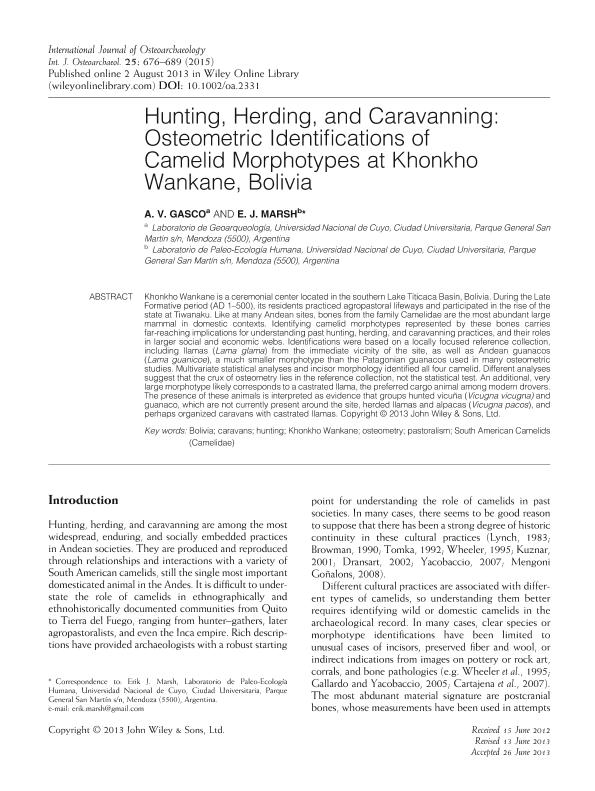Mostrar el registro sencillo del ítem
dc.contributor.author
Gasco, Alejandra Valeria

dc.contributor.author
Marsh, Erik Johnson

dc.date.available
2018-09-14T19:00:02Z
dc.date.issued
2015-09
dc.identifier.citation
Gasco, Alejandra Valeria; Marsh, Erik Johnson; Hunting, Herding, and Caravanning: Osteometric Identifications of Camelid Morphotypes at Khonkho Wankane, Bolivia; John Wiley & Sons Ltd; International Journal of Osteoarchaeology; 25; 5; 9-2015; 676-689
dc.identifier.issn
1099-1212
dc.identifier.uri
http://hdl.handle.net/11336/59759
dc.description.abstract
Khonkho Wankane is a ceremonial center located in the southern Lake Titicaca Basin, Bolivia. During the Late Formative period (AD 1-500), its residents practiced agropastoral lifeways and participated in the rise of the state at Tiwanaku. Like at many Andean sites, bones from the family Camelidae are the most abundant large mammal in domestic contexts. Identifying camelid morphotypes represented by these bones carries far-reaching implications for understanding past hunting, herding, and caravanning practices, and their roles in larger social and economic webs. Identifications were based on a locally focused reference collection, including llamas (Lama glama) from the immediate vicinity of the site, as well as Andean guanacos (Lama guanicoe), a much smaller morphotype than the Patagonian guanacos used in many osteometric studies. Multivariate statistical analyses and incisor morphology identified all four camelid. Different analyses suggest that the crux of osteometry lies in the reference collection, not the statistical test. An additional, very large morphotype likely corresponds to a castrated llama, the preferred cargo animal among modern drovers. The presence of these animals is interpreted as evidence that groups hunted vicuña (Vicugna vicugna) and guanaco, which are not currently present around the site, herded llamas and alpacas (Vicugna pacos), and perhaps organized caravans with castrated llamas.
dc.format
application/pdf
dc.language.iso
eng
dc.publisher
John Wiley & Sons Ltd

dc.rights
info:eu-repo/semantics/openAccess
dc.rights.uri
https://creativecommons.org/licenses/by-nc-sa/2.5/ar/
dc.subject
Bolivia
dc.subject
Caravans
dc.subject
Hunting
dc.subject
Khonkho Wankane
dc.subject
Osteometry
dc.subject
Pastoralism
dc.subject
South American Camelids (Camelidae)
dc.subject.classification
Historia

dc.subject.classification
Historia y Arqueología

dc.subject.classification
HUMANIDADES

dc.title
Hunting, Herding, and Caravanning: Osteometric Identifications of Camelid Morphotypes at Khonkho Wankane, Bolivia
dc.type
info:eu-repo/semantics/article
dc.type
info:ar-repo/semantics/artículo
dc.type
info:eu-repo/semantics/publishedVersion
dc.date.updated
2018-09-14T14:14:40Z
dc.journal.volume
25
dc.journal.number
5
dc.journal.pagination
676-689
dc.journal.pais
Estados Unidos

dc.journal.ciudad
Hoboken
dc.description.fil
Fil: Gasco, Alejandra Valeria. Consejo Nacional de Investigaciones Científicas y Técnicas; Argentina. Universidad Nacional de Cuyo; Argentina
dc.description.fil
Fil: Marsh, Erik Johnson. Consejo Nacional de Investigaciones Científicas y Técnicas; Argentina. Universidad Nacional de Cuyo; Argentina
dc.journal.title
International Journal of Osteoarchaeology
dc.relation.alternativeid
info:eu-repo/semantics/altIdentifier/doi/https://dx.doi.org/10.1002/oa.2331
dc.relation.alternativeid
info:eu-repo/semantics/altIdentifier/url/https://onlinelibrary.wiley.com/doi/abs/10.1002/oa.2331
Archivos asociados
